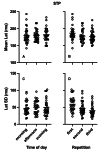Diurnal variation and practice effects in saccade task performance
- PMID: 40699362
- PMCID: PMC12287220
- DOI: 10.1007/s00221-025-07131-7
Diurnal variation and practice effects in saccade task performance
Abstract
Saccadic eye movement tasks have been widely used as a probe for measuring cognitive functions in healthy humans as well as in patients with neurological and psychiatric disorders. Circadian variation has been shown to affect multiple aspects of cognitive function especially executive function related to prefrontal cortex. The effects of diurnal variation in saccadic task performance and the dissociation of these effects from repetition or practice effects has not been adequately addressed. In the current study thirty healthy adults performed several saccadic eye movement tasks including visually guided saccades, antisaccades and countermanding saccades in three consecutive sessions. Participants were divided into three groups, with a different starting time of the sequence of the three sessions across groups (morning or afternoon or evening) to examine the effect of diurnal variation (time of day that the tasks were performed) separated from the effect of session repetition (practice effect). The results showed no effect of diurnal variation for all indexes of saccadic eye movement performance including accuracy (antisaccade and countermanding saccade tasks) speed (mean latency in all tasks) and stability (intra-subject standard deviation of latency in all tasks). In contrast, saccadic task repetition significantly improved accuracy, speed and stability of performance indicating the presence of practice effects in these tasks. Finally, linear mixed model analysis confirmed no interaction between diurnal variation and practice effects for all indexes of saccadic eye movement performance. In conclusion our study provides confirmation that saccadic task performance is not affected by diurnal variation related to circadian rhythms. In contrast, short term repetition of these tasks results in significant practice effects.
Keywords: Antisaccade; Countermanding saccade; Gap saccade; Oculomotor tasks; Saccadic latency; Visually guided saccade.
© 2025. The Author(s).
Conflict of interest statement
Declarations. Conflict of interest: The authors declare no competing interests.
Figures






References
-
- Albouy G, Ruby P, Phillips C, Luxen A, Peigneux P, Maquet P (2006) Implicit oculomotor sequence learning in humans: time course of offline processing. Brain Res 1090:163–171. 10.1016/j.brainres.2006.03.076 - PubMed
-
- Antoniades CA, Spering M (2024) Eye movements in parkinson’s disease: from neurophysiological mechanisms to diagnostic tools. Trends Neurosci 47:71–83. 10.1016/j.tins.2023.11.001 - PubMed
-
- Antoniades C, Ettinger U, Gaymard B et al (2013) An internationally standardised antisaccade protocol. Vis Res 84:1–5. 10.1016/j.visres.2013.02.007 - PubMed
-
- Borozan M, Loreta C, Riccardo P (2022) Eye-tracking for the study of financial decision-making: A systematic review of the literature. J Behav Exper Finance 35:100702. 10.1016/j.jbef.2022.100702
MeSH terms
LinkOut - more resources
Full Text Sources
Miscellaneous

